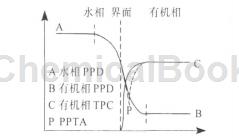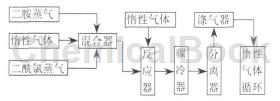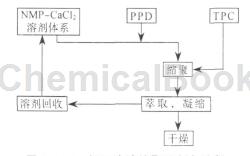Overview[1]
Poly(p-phenylene terephthalamide) is an all-para-polyaramid formed by the condensation polymerization of p-phenylenediamine and terephthaloyl chloride. It has a rigid chain structure. It can form an anisotropic polymer liquid crystal solution, which can be used for spinning to obtain high-strength, high-modulus fibers with particularly excellent properties. The trade name is Kevlar fiber, and it is called aramid fiber in China. In the early days of interfacial condensation polymerization research in 1958, there were reports on the synthesis of this all-para polyaramid. In the early 1970s, low-temperature solution polycondensation in highly polar amide solvents was used to synthesize high molecular weight polymers.
Performance features[2]
Among the existing high-performance fibers, poly(p-phenylene terephthalamide) is the organic fiber with the best comprehensive performance. Its outstanding performance characteristics are high temperature resistance, high strength and high modulus; it also has wear resistance and flame retardancy. , anti-cut, anti-fatigue and good flexibility, etc., which will be introduced in detail in the following sections:
1) Mechanical properties: High strength and high modulus are the most important mechanical properties of poly(p-phenylene terephthalamide) fiber. For example, the strength of Kevlar fiber is 3 times that of steel wire and about 4 times that of polyester filament; its initial modulus is about 4 to 10 times that of polyester filament and more than 10 times higher than nylon filament.
2) Thermal properties: Another feature of polyphenylene terephthalamide fiber is high temperature resistance. As shown in Table 1, the glass transition temperature and thermal decomposition temperature of poly-p-phenylene terephthalamide are higher than 270°C and 430°C respectively.
3) Flame retardancy: Poly(p-phenylene terephthalamide) has a relatively high combustion temperature and LOI (limiting oxygen index) value. It is difficult to ignite at high temperatures of 500~600°C and has excellent performance. For flame retardant materials, the data in Table 1 confirms the above point of view.
4) Weather resistance: Poly(p-phenylene terephthalamide) is extremely sensitive to ultraviolet rays and electron rays, and visible light has a minor impact on it. Light with a wavelength of 300~450nm is easily absorbed by poly(p-phenylene terephthalamide), causing the amide groups in the molecular chain to cleave, resulting in a decrease in material performance.
5) Creep resistance: Because poly(p-phenylene terephthalamide) has high crystallinity and unidirectionality, its creep resistance is very low. Although poly(p-phenylene terephthalamide) has some shortcomings, from a comprehensive analysis, poly(p-phenylene terephthalamide) is still a polymer material with excellent performance.
Apply[2]
There are three main varieties of Kevlar fiber: ①Kevlar fiber: mainly used as reinforcing material for tire cords and rubber products; ②Kevlar-29 fiber: used for special ropes and industrial fabrics; ③Kevlar-49 fiber: used as plastic reinforcing material. Such as aerospace materials and missile casing materials.
1. Aviation and transportation fields
Polyphenylene terephthalamide composites are used as structural materials for rockets and aircraft, which can reduce their own weight and increase their loads. Polyphenylene terephthalamide composites are also used in automotive components (such as drive shafts, body chassis, doors, panels and water tanks, etc.).
2. High modulus in military field
The energy propagation speed of poly(p-phenylene terephthalamide) is 4 times that of high-strength nylon. Although carbon fiber has high strength and modulus, its brittleness limits its application as soft body armor. High-strength polyethylene fiber has ultra-high strength and modulus, which is very suitable for the application of soft bulletproof materials. However, bulletproof materials sometimes generate considerable heat when preventing projectiles from intruding, and the molten layer of the polymer may promote the intrusion of projectiles. . Therefore, polyparaphenylene terephthalamide fiber has unparalleled advantages and can provide higher friction resistance.
3. Construction field
Polyphenylene terephthalamide has excellent properties such as high strength, high modulus, low ductility and electrical insulation, making it an ideal choice for composite reinforcement materials in construction. In addition to its high strength, high modulus and corrosion resistance, poly(p-phenylene terephthalamide) composite materials also have strong alkali corrosion resistance, non-conductivity, impact resistance, fatigue resistance and other properties, making them widely used In projects such as harbor terminals, subways, tunnels and railways.
Preparation[3]
The synthesis methods of poly-p-phenylene terephthalamide can be roughly divided into the following types.
1. Interfacial polycondensation method
Relevant literature on the interfacial polycondensation method was first published by DuPont in 1959. Dissolve the dicarboxylic acid chloride (such as terephthaloyl chloride (TPC)) in an organic solvent that is immiscible with water, and then dissolve the diamine (such as p-phenylenediamine (PPD)) in the water (add a small amount of NaCO3 or NaOH to absorb the hydrochloric acid generated by the reaction), and then mix the above two solutions. At the moment of mixing, a polycondensation reaction occurs at the interface of the two liquids, forming a polymer film. Because the reaction occurs at the interface, it is called Interface condensation. During the interfacial polycondensation reaction, the concentration distribution of monomers and polymers is shown in the figure.

Remove the polymer film formed near the interface, and new films will continue to form at the interface. In order to obtain a powdery or granular polymer with high yield and easy to separate, wash and dry, stirring is also required. Usually, acid chloride liquid prepared with an organic solvent is added to a stirred diamine aqueous solution. The reaction starts at room temperature. Due to the exothermic reaction, the temperature can rise to 50~60°C, and the resulting polymer is separated. In this synthesis method, the appropriate organic solvent and the concentration ratio of the reactants are all important factors. This method has great theoretical significance, but it cannot be produced continuously, and the relative molecular weight of the polymer decreases in the later stages of the reaction, so it cannot be applied in practice.
2. Transesterification
In the presence of diaryl sulfone (such as diphenyl sulfone) and an ether or hydrocarbon with two benzene rings or naphthalene rings, the aromatic diarotic acid diaryl ester and aromatic diamine are heated and polycondensed. The reaction temperature is higher than 150°C, and the optimum is 180~400°C. The reaction time is 2~30h. In order to accelerate the reaction, catalysts for polyester exchange reaction and polycondensation reaction can be added. In the early stage of the reaction, the reaction is carried out under normal pressure, and the generated aromatic hydroxyl compounds do not need to be discharged. In the later stage of the reaction, the by-products and part of the solvent must be evaporated, so its application is greatly limited.
3. Gas phase polymerization method
Vaporize aromatic diamines and aromatic diacyl chlorides, mix them in the presence of inert gas and gaseous tertiary amine compounds (such as triethylamine or pyridine), and then mix them in a tubular reactor or carrier reactor Carry out a gas phase polycondensation reaction with a monomer content of 2% to 50%, a reaction temperature of 150 to 500°C, and a reaction time of 0.1 to 5 seconds. Then, the polymer is obtained by cooling, separating and removing hydrogen chloride. The aromatic polyamide produced by this method can be spun into fibers by dry method, wet method or dry-wet method.

Low-temperature solution polycondensation method Low-temperature solution polycondensation method is currently the most mature synthesis method for the synthesis of poly-p-phenylene terephthalamide. This method is used in the synthesis of industrialized Kevlar, Twaron, and Technical fibers. The process flow of this method is shown in the figure.

Main reference materials
[1] Encyclopedia of China (Chemistry Volume)
[2] Application and development of poly(p-phenylene terephthalamide) in China
[3] Synthesis method of poly-p-phenylene terephthalamide
Application development
[3] Synthesis method of poly-p-phenylene terephthalamide


